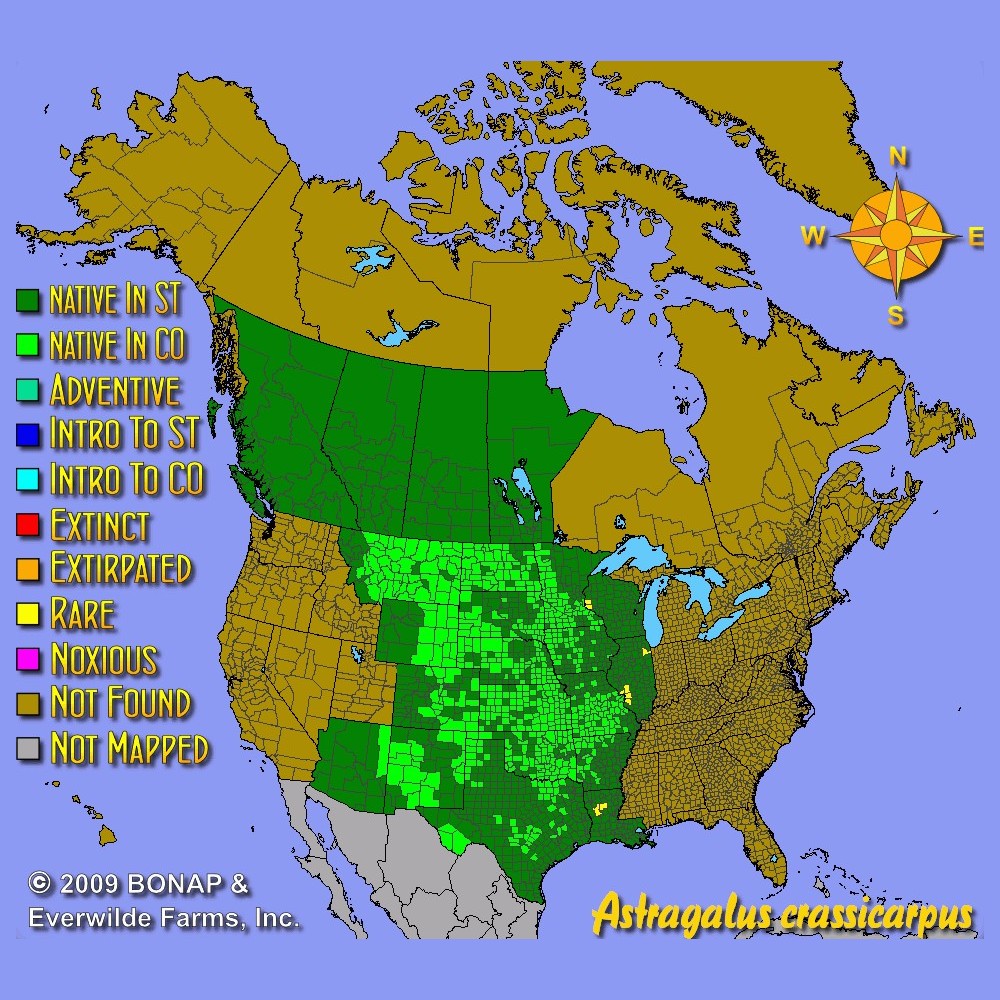Ground Plum Seeds
- HOW TO GROW
- FAST FACTS
- REVIEWS
HOW TO GROW
Sowing: Before planting, scarify by pouring hot water over the Ground Plum seed and soaking it for 24 hours. For fall planting, direct sow the Astragalus Crassicarpus seed 1/2" deep; it will remain dormant until spring. Scarified seed can also be direct sown in early spring, but this plant does not transplant well and should not be started indoors. Germination may be slow.
Growing: This plant adapts to many kinds of soil including sand, clay, or gravel, but prefers well drained soil and full sun; it cannot tolerate shade. It grows rather slowly. Young plants may need occasional watering, but mature plants can tolerate drought conditions. Its low branches will sprawl along the ground. As well as being a good choice for rock gardens, this plant does well in heat and humidity and attracts butterflies and bees.
Harvesting: Though the young fruits are edible, Ground Plum strongly resembles various poisonous native plants, and its fruit should not be eaten without positive identification. The 1" unripe seed pods look like small plums, and can be eaten raw or cooked.
Seed Saving: In midsummer, the 1" fruits will form, looking something like a purple and green plum. The Ground Plum seeds will be mature when the dry fruit eventually develops a thick, wrinkled tan skin and the seeds rattle inside. Remove the pods and open them to harvest the Astragalus Crassicarpus seed.
FAST FACTS
Common Names: Groundplum Milkvetch, Buffalo Bean, Buffalo Plum
Latin Name: Astragalus crassicarpus
Species Origin: US Native Wildflower
Type: Native Wildflowers
Life Cycle: Perennial
USDA Zones: 2, 3, 4, 5, 6, 7, 8
US Regions: Mountain, Arid/Desert, Plains/Texas, Midwest
Seeds per Ounce: 4,400
Stratification: Cold/Wet for 1 Week
Germination Ease: Stratify 1 Week
Sunlight: Full Sun
Height: 20 Inches
Color: Purple
Bloom Season: Blooms Late Spring
Too late in the season to grow.
Will plant this in early spring hope it works out first time trying.
DESCRIPTION

HOW TO GROW
Sowing: Before planting, scarify by pouring hot water over the Ground Plum seed and soaking it for 24 hours. For fall planting, direct sow the Astragalus Crassicarpus seed 1/2" deep; it will remain dormant until spring. Scarified seed can also be direct sown in early spring, but this plant does not transplant well and should not be started indoors. Germination may be slow.
Growing: This plant adapts to many kinds of soil including sand, clay, or gravel, but prefers well drained soil and full sun; it cannot tolerate shade. It grows rather slowly. Young plants may need occasional watering, but mature plants can tolerate drought conditions. Its low branches will sprawl along the ground. As well as being a good choice for rock gardens, this plant does well in heat and humidity and attracts butterflies and bees.
Harvesting: Though the young fruits are edible, Ground Plum strongly resembles various poisonous native plants, and its fruit should not be eaten without positive identification. The 1" unripe seed pods look like small plums, and can be eaten raw or cooked.
Seed Saving: In midsummer, the 1" fruits will form, looking something like a purple and green plum. The Ground Plum seeds will be mature when the dry fruit eventually develops a thick, wrinkled tan skin and the seeds rattle inside. Remove the pods and open them to harvest the Astragalus Crassicarpus seed.
FAST FACTS
Common Names: Groundplum Milkvetch, Buffalo Bean, Buffalo Plum
Latin Name: Astragalus crassicarpus
Species Origin: US Native Wildflower
Type: Native Wildflowers
Life Cycle: Perennial
USDA Zones: 2, 3, 4, 5, 6, 7, 8
US Regions: Mountain, Arid/Desert, Plains/Texas, Midwest
Seeds per Ounce: 4,400
Stratification: Cold/Wet for 1 Week
Germination Ease: Stratify 1 Week
Sunlight: Full Sun
Height: 20 Inches
Color: Purple
Bloom Season: Blooms Late Spring
Reviews
Review
Too late in the season to grow.
Will plant this in early spring hope it works out first time trying.




